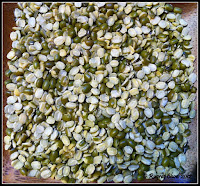After an almost 3 week hiatus, I'm back on the 'New Veggie' wagon and the latest honoree and New Veggie #27 is the mighty Artichoke. After years and years of only eating Spinach and Artichoke dip in restaurants, I decided to give this beautiful vegetable a try at home.
Prep Time: 20 min
Ingredients:
- 1 medium Artichoke
- 1/4 cup Soy milk
- 1 tbsp minced garlic
- 1 tbsp minced dried onion flakes
- 8-10 mushrooms, quartered.
- 5-6 fresh Basil leaves, finely diced
- Salt and freshly cracked pepper, to taste.
Cleaning and Preparing Artichokes:
The most interesting fact I learnt about artichokes - when you're buying one, try pressing the bulb together, and it should talk to you :) !! The leaves squeak when they rub together and that is a good sign that it is a fresh bulb. To prepare it for cooking, wash the artichoke under cold running water, turn it upside down and give it a good shake to get rid of excess water; then dry it with a clean towel. Using a sharp Chef's knife, cut off the top inch of the artichoke - the portion where the leaves are tightly bunched together. Then, using a pair of kitchen scissors, cut off the sharp points from the remaining leaves. Now cut the bulb into quarters and scoop out all the purple leaves and the "hairs" that cover the artichoke heart. A paring knife works best at this point. Keep a bowl of water (with the juice of half a lemon) handy and as you clean up each piece, drop the cleaned pieces in it to prevents the artichokes from discoloration - which happens quite quickly upon exposure to air. Remove as many of the tough leaves - the easiest way is to simply grab each leaf, starting with the outermost and pulling downward towards the stem. Once the inner pale leaves are exposed, you're ready to do the final touch up. Use the paring knife remove any hard portions near the stem. Cut off the stem and wash well to remove any hairs clinging to the heart. I cut my artichoke into 8 wedges this evening.
Directions:
Line a skillet with soy milk and add minced garlic and onion. Saute garlic for a couple of minutes and then add artichoke wedges, toss well, cover and cook for about 10 minutes until the leaves are nice and tender. Add another splash of soy milk, as needed, if it begins to look dry. Add mushrooms (any kind, I used baby bellas this evening). Cook for a couple of minutes until the mushrooms warm up. I don't typically like to cook down mushrooms as I like the meaty texture of mushrooms. After a couple of minutes, add freshly diced basil, toss well and serve over warm couscous. The dish should be very moist with the soy milk almost all evaporated to a creamy texture.

My Assessment: I really really enjoyed dinner today. I loved the creamy goodness of soymilk on the artichoke and the garlic really added to the flavor as well. This was like eating artichoke dip, without any of the high calorie ingredients in the restaurant variety. Next time, I might make this with baby spinach instead of mushrooms to see if how close I can get to the restaurant style Spinach and artichoke dip. One lesson learnt - do not be frugal about removing the outermost tough leaves. I left a few that should have been removed and they were really tough to eat. In the end I didn't eat them, and they increased my cook time as well.
 |
| My Herb Garden |
Today was also the first time I used herbs out of my own little herb garden. I started it 2 weeks ago and now that it has had a chance to establish its roots a little bit, I took my first harvest.



































